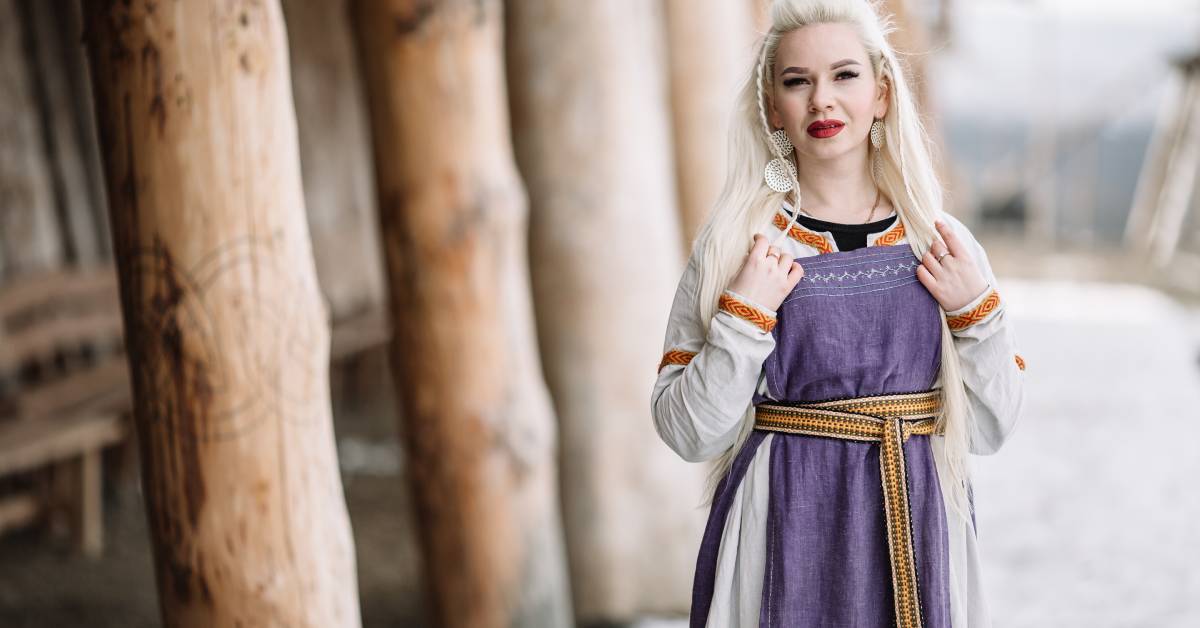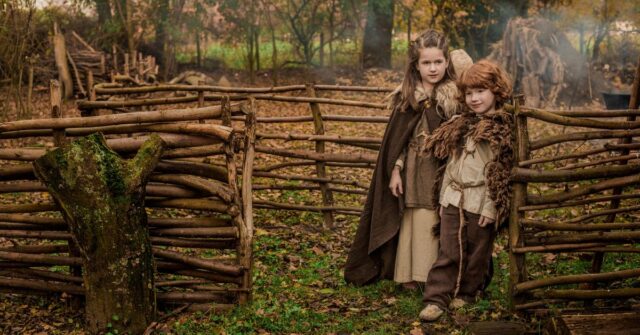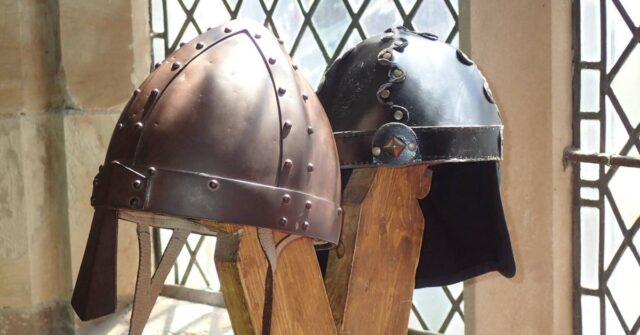The Viking apron dress, also known as the “hangerock” or “smokkr”, is a fascinating part of Viking culture and clothing style.
This garment, typically worn by women, offers us insight into the aesthetics, societal structures, and technological skills of the Viking era.
This article aims to delve into the depths of everything you need to know about this interesting piece of Viking clothing.
Introduction to Viking Clothing
Before diving into the specifics of the Viking apron dress, it’s important to understand the broader context of Viking clothing.
The apparel of the Viking era was practical, and suitable for the harsh Nordic climate, but also showcased their artistic style and societal status.
Overview of the Viking Era
The Viking era is typically dated from the late 8th century to the early 11th century. During this time, the Scandinavian Norse seafarers left a significant impact on the regions they explored and traded with, including Europe, Asia, and North America.
This era is characterized by rapid expansion, exploration, and cultural exchange.
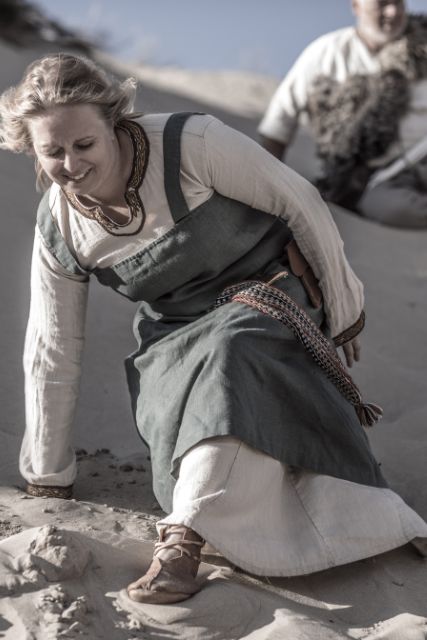
Significance of Clothing in Viking Society
Clothing in Viking society was not just about protection from the elements. It was a clear indication of a person’s status, wealth, and role within the community.
Quality materials, intricate designs, and adornments were a testament to the wearer’s position and were often associated with prosperity and respect.
Viking Clothing Styles
Viking clothing was functional and practical, made to withstand the harsh Nordic climate. However, it also carried an aesthetic value.
Men and women both wore tunics, trousers or dresses, and cloaks, made from wool, linen, or sometimes silk for the wealthy.
Women’s clothing, in particular, was often decorated with bands of colored wool, silk, or silver wire, indicating their skill in textile work.
The Viking Apron Dress: An Overview
The Viking apron dress, a staple in a Viking woman’s wardrobe, was a versatile and important garment. It provided warmth and modesty, but also a canvas for display of personal style, wealth, and status.
Definition and Description
The Viking apron dress, also known as a ‘hangerok’ or ‘smokkr’, is a type of overgarment that was typically worn over a long-sleeved underdress.
It was essentially a tube of fabric, open at the sides, held up by straps over the shoulders. The straps were attached to the dress with brooches, often elaborate and ornamental. This allowed the apron dress to be adjusted to fit different body sizes and shapes.
Historical Context
The Viking apron dress was common during the Viking Age, as depicted in various archaeological finds and ancient Norse texts. It was an everyday garment for women of all societal statuses, albeit with varying degrees of decoration and quality of fabric.
Over time, the style, fit, and adornments of the apron dress changed, reflecting evolving fashion trends, technological advancements, and cultural influences.
Construction of the Viking Apron Dress
The Viking apron dress is a testament to the craftsmanship and skills of Viking women. The process of constructing such a garment involved the knowledge of weaving, sewing, and often ornamentation. Let’s delve into this process in more detail.
Materials Used
The primary materials for Viking apron dresses were wool and linen, with wool being the most common due to its availability and resilience to the Nordic climate.
Higher-ranking individuals might have used imported materials such as silk for a more luxurious appearance.
Dyed fabrics were common, with colors ranging from natural off-whites and browns to vibrant reds, blues, and yellows obtained from plant and mineral dyes.
Method of Construction
The construction of a Viking apron dress was a multi-step process that required skills in fabric production, pattern cutting, and sewing. The final product was a durable and practical garment that could withstand the rigors of everyday Viking life.
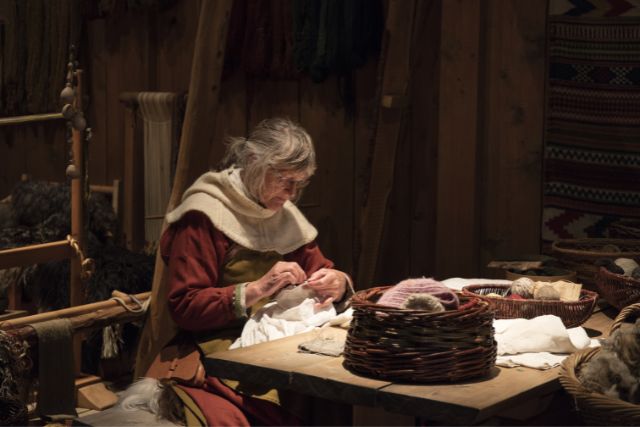
Preparing the Fabric
Preparation began with the production of the fabric itself. Wool was sheared from sheep, cleaned, carded to align the fibers, and then spun into thread using a drop spindle.
The thread was then woven into the fabric using a loom. If linen was used, it was derived from the flax plant through a complex process of retting, scutching, and hackling before being spun into thread and woven.
Cutting and Sewing
Once the fabric was ready, it was cut into panels based on the wearer’s measurements. These panels were then sewn together using woolen thread and a bone or iron needle.
The apron dress was typically open on the sides and was held together by the shoulder straps, allowing for easy adjustment and accommodation of different body sizes.
Creating the Straps
The straps of the apron dress were crucial for holding the garment in place. They were made from the same fabric as the dress, cut into long strips, folded, and then sewn to create sturdy bands.
These were then attached to the front and back of the dress at the desired length. Brooches were used to fasten the straps to the dress, serving both a functional and decorative purpose.
Styles and Variations
The Viking apron dress was not a monolithic design; rather, it showed a variety of styles and variations across different regions and periods. These variations can provide us with fascinating insights into the diversity and dynamism of Viking society.
Regional Variations
Different regions across the Viking world had their own distinctive styles of apron dress. In some regions, the dresses were long, reaching down to the ankles, while in others, they were shorter, ending just below the knee.
The design of the straps also varied, with some dresses having narrow, straight straps and others having broader, more elaborately decorated ones. The choice of fabric and colors also varied depending on local resources and preferences.
Class and Status Representation
The Viking apron dress was a clear indicator of a woman’s social status. Wealthier women could afford higher quality fabrics and more elaborate decorations, such as intricate embroidery or ornate brooches.
In contrast, the apron dresses of lower-status women were likely simpler and made from less expensive materials.
However, regardless of social status, all Viking women took pride in their dressmaking skills and aimed for aesthetic appeal in their garments.
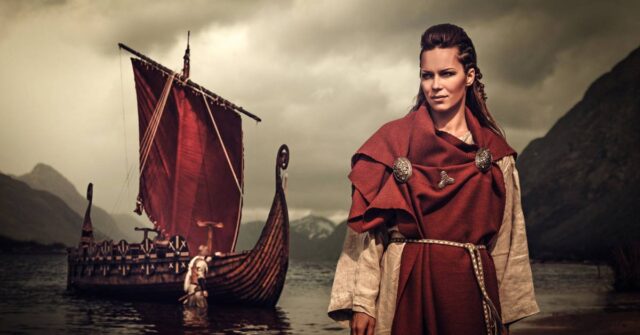
Variations over Time
Just like in any society, fashion in the Viking Age evolved over time. Earlier apron dresses from the 8th and 9th centuries were generally simpler and more practical.
As trade routes expanded and cultural exchanges increased in the 10th and 11th centuries, apron dresses started to reflect a wider range of styles, materials, and adornments.
It’s important to note that our understanding of these variations is based on archaeological evidence, which provides a snapshot rather than a complete picture of Viking fashion.
Adornments and Accessories
Viking apron dresses were often embellished with various adornments and were accompanied by an array of accessories. These elements added not only aesthetic value but also conveyed information about the wearer’s social status, beliefs, and personal taste.
Brooches and Pins
Brooches and pins were not only functional elements used to hold the apron dress in place, but they were also significant decorative accessories.
Made from metals such as bronze, silver, or even gold, they often featured intricate designs, including animal motifs, geometric patterns, and mythological scenes.
The choice of brooch design and material could indicate a woman’s social status, family connections, or religious beliefs.
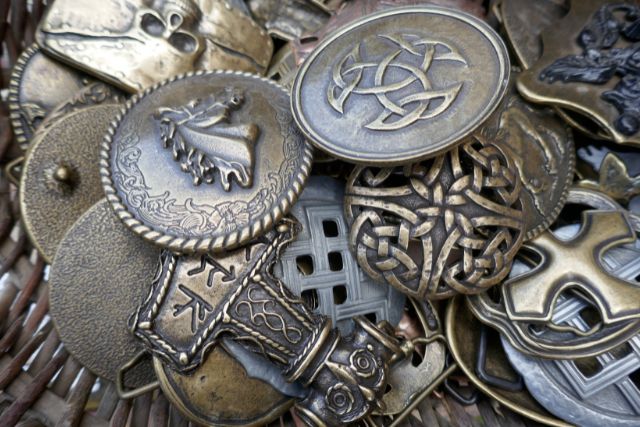
Beads and Necklaces
Viking women often wore necklaces and strings of beads with their apron dresses. The beads were made from a variety of materials including glass, amber, metal, and semi-precious stones.
Like brooches, they offered an additional avenue for women to express their personal style and status.
Belts and Pouches
Belt accessories were also commonly used with Viking apron dresses. The belt itself was often decorated, and small pouches, tools, or keys could be hung from it.
The practicality of the Viking apron dress was further enhanced by these functional accessories, underscoring the blend of aesthetics and practicality that characterized Viking clothing.
Significance in Viking Culture and Society
The Viking apron dress was much more than a garment for warmth and modesty. Its construction, adornments, and variations reveal a great deal about Viking society, culture, and even beliefs.
Apron Dress in Everyday Life
In everyday life, the Viking apron dress was a practical garment. Its adjustable nature made it suitable for different activities and body types.
It was an integral part of a Viking woman’s outfit, worn while working, traveling, and participating in social events. The quality and decoration of the dress also provided visible indicators of a woman’s skills, status, and wealth.
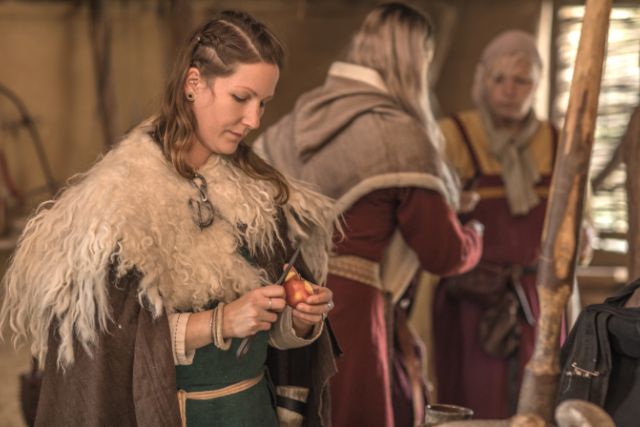
Apron Dress in Rituals and Ceremonies
Viking apron dresses also had ceremonial significance. They were often worn at key life events such as weddings, naming ceremonies, and funerals, as well as at communal feasts and religious ceremonies.
The decoration and quality of the dress for such occasions would typically be more elaborate, with additional adornments such as brooches, beads, and belts.
Symbolism and Meanings
The Viking apron dress, with its various elements, carried symbolic meanings. Colors, patterns, and the choice of adornments could represent personal, familial, or tribal identities.
Certain motifs in the decoration, particularly on brooches, might have spiritual or mythological significance. Studying these symbols helps us understand the mindset and belief systems of the Viking people.
Archaeological Evidence and Interpretations
The Viking apron dress, like much of Viking culture, is primarily known to us through archaeological evidence. These findings, along with textual sources, help shape our understanding of this iconic garment.
Discoveries of Apron Dresses
Archaeological evidence for Viking apron dresses comes from several sources. These include burial sites where fragments of fabric and associated adornments have been preserved and pictorial representations on runestones or in manuscript illuminations.
Each find adds a piece to the puzzle of Viking dress and provides valuable information about its construction, style, and use.
Interpretations and Debates
Interpreting archaeological findings can be challenging, leading to debates among scholars.
Issues of interpretation include the dating of finds, the reconstruction of garments from fragmentary remains, and the extrapolation of societal norms from material evidence.
Despite these challenges, a consensus exists on the basic form and significance of the Viking apron dress, while ongoing research continues to enrich our understanding.
Recreating Viking Apron Dresses Today
Recreating Viking apron dresses is a popular activity among enthusiasts of Viking history, reenactors, and those interested in historical clothing. These recreations provide a hands-on understanding of Viking craftsmanship and culture.
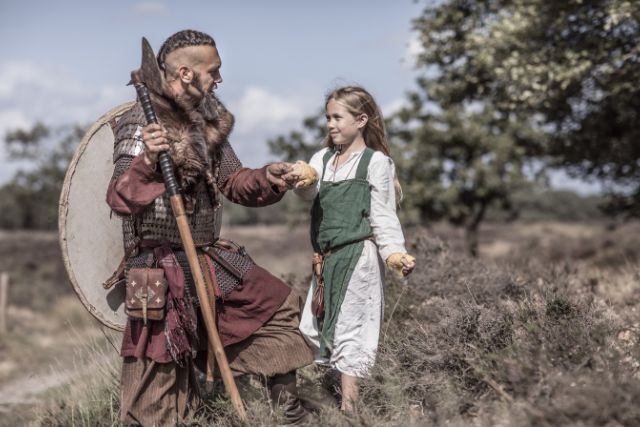
Role in Historical Reenactments
Viking apron dresses play a crucial role in historical reenactments, offering a tangible link to the past. They help participants embody their roles more authentically and offer spectators a visual feast.
In creating these dresses, reenactors often strive for accuracy, following archaeological evidence and historical records closely.
Techniques for Recreation
Recreating a Viking apron dress involves several steps that mirror the original construction techniques.
This includes weaving or sourcing suitable fabric, cutting the fabric based on measurements, sewing the dress and straps, and adding appropriate adornments.
Many reenactors also try to use period-appropriate tools and techniques, such as hand sewing and natural dyes, to enhance the authenticity of their recreations.
Modern Interpretations and Adaptations
While some prefer historical accuracy, others take a more creative approach to the Viking apron dress, adapting it to modern fashion sensibilities.
These modern interpretations may feature new fabrics, colors, or embellishments, while still retaining the core elements of the original design. Such adaptations demonstrate the ongoing influence and appeal of Viking aesthetics.
Conclusion: The Viking Apron Dress in Perspective
The Viking apron dress, a seemingly simple garment, is a window into the vibrant and complex world of the Vikings. It showcases their craftsmanship, aesthetics, societal structures, and cultural dynamism.
Whether studied by historians, recreated by reenactors, or adapted by modern designers, the Viking apron dress continues to captivate and inspire.

